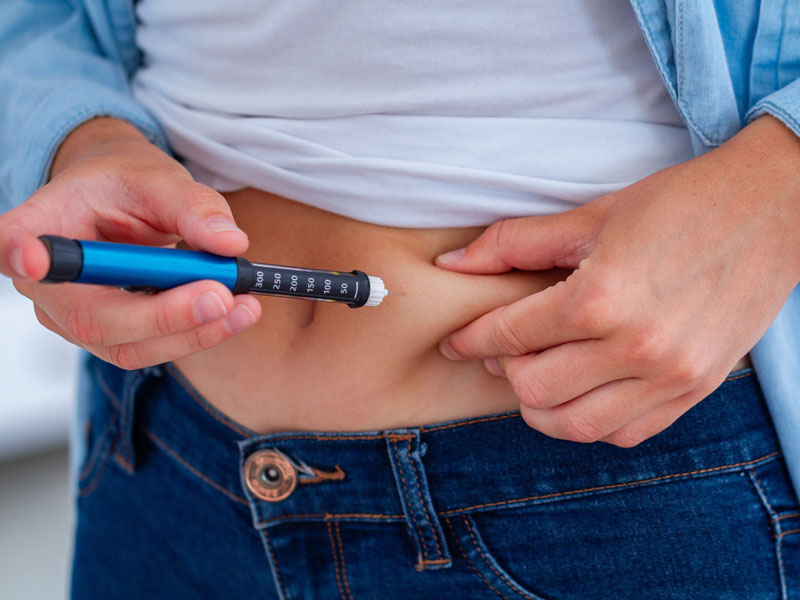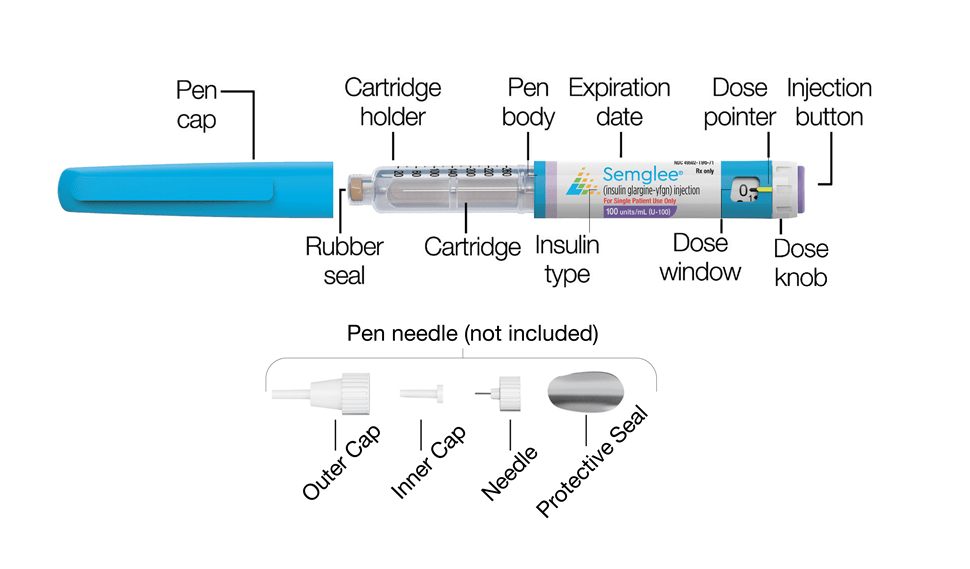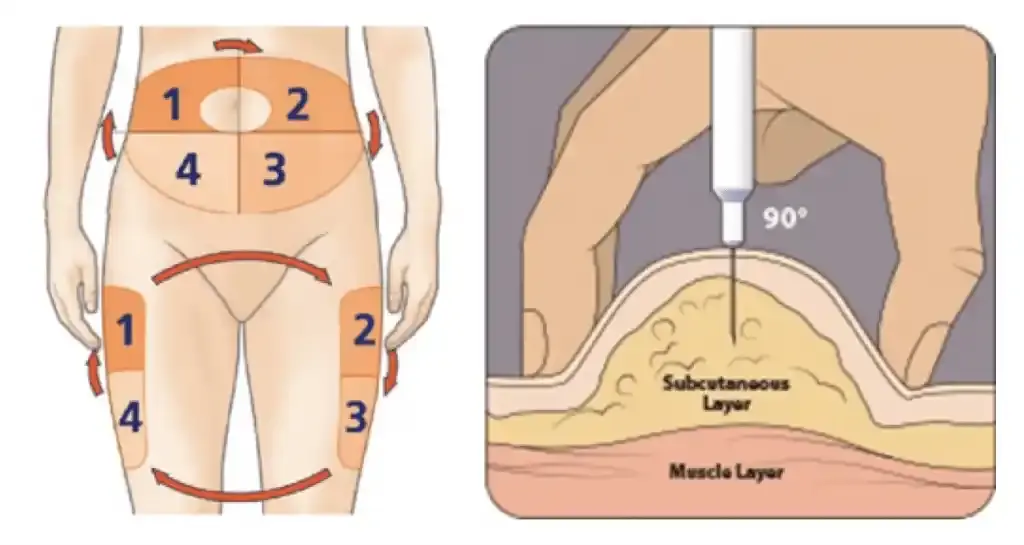
Insulin Injection: A Step By Step Guide
It would be an understatement to say that insulin is a lifesaver for people with diabetes. However, for most diabetics, oral metformin is not an option. The only way to take insulin is through an injection with a syringe or pen. So naturally, this can be quite intimidating to those who are about to start taking it.
Some people may have concerns about the process being painful. Others may worry that self-injection is too difficult. However, nowadays, there is no need for such concerns.
Modern insulin pens and syringes are a lot easier to use. Not to mention, they hurt a lot less. Although it may take a while to get comfortable with the process, all you need is a little practice.
In this article, we will give you a rundown of how standard insulin injections work. If you have any specific concerns that are not covered here, reach out to your healthcare provider for guidance.
Insulin Injection: How To
The method for insulin injection varies depending on the technique you choose. This section will walk you through the basic steps to follow for each method. However, if your healthcare provider gives you individualized instructions, always make sure to follow them first.
Irrespective of the technique you use, there are some general guidelines you should follow. First, before starting the actual injection process, make sure your hands are clean and washed. Then gather the necessary supplies. Get your insulin pen or vial, a new needle, and an alcohol swab. Also, grab a sharps container and a magnifier if necessary.
Now, let’s talk about how to inject insulin, along with the steps to follow for each technique.
With An Penfill Insulin Pen
Here is how you can administer insulin with an penfill insulin pen:
- First, use an alcohol swab to disinfect the injection site and let the alcohol dry.
- Ensure that the penfill insulin pen you are using is the right one. Often, people will have two penfill insulin pen: one for long-acting insulin and the other for rapid-acting mealtime insulin. If that is the case, make sure that you are using the right one.
- Uncap the penfill insulin pen and attach a new needle. Then take off the protective cap.
- Adjust the dial to the appropriate insulin dose.
- Pinch the skin at the injection site. Then carefully press the needle straight into it at a 90-degree angle. Remember to be gentle, as the needle is thin.
- Loosely hold the insulin barrel. Then press down on the plunger with your thumb to start injecting the insulin. One tip to keep in mind is to count to ten as you do this. That way, you will never make the mistake of removing the needle before you’ve administered the entire dose.
- After that, you can lift the pen out of the injection site. Cover the pen’s needle with the clear cap and then twist it off. Ensure you dispose of it correctly in the container.
- Once you have replaced the cap on the pen, you can then store it. When doing so, always remember to remove the needle.

With A Syringe
Follow these suggestions to use insulin with a hypodermic needle:
- First, clean the location with an alcohol cotton ball and let it dry fully. Next, use another cotton ball to sterilize the top of the insulin vial.
- Make sure that the vial is within its expiration date. Also, check that no bits are floating around in your insulin. However, gently roll the vial between your hands for a bit, If you’re using mixed insulin. This will mix the insulin a little more. It’ll also warm up the contents if you have just taken it out of the refrigerator
- Uncap the needle and draw the hypodermic needle’s plunger back.
- Press the needle until it pushes past the rubber barrier at the top of the vial. While you are doing this, ensure that the vial is lying flat on level hard surface. At this point, press out the air from the hypodermic needle into the vial.
- With the needle still inside the vial, turn it upside down. This angle will allow insulin to flow into the hypodermic needle when you draw the plunger back. You can stop as it fills up with the required dosage.
- Then again, turn the vial upside down. Check the hypodermic needle for any air bubbles that may have formed. However, use your hand to shake the needle until the bubbles rise to the top, If you find any. Also, push them out by gently pressing the plunger. After that, you ’ll need to pull the insulin back again till you reach the desired dosage.
- Take the needle out of the vial. Double- check that the dosage you have is accurate.
- Pinch the disinfected skin. Put the needle straight into it at a 90- degree angle. Press down on the plunger to insert the insulin.
- Count to five rather of ten to make sure the complete delivery of the insulin.
- Dispose of the used hypodermic needle in a sharps bucket.

Do’s And Don’ts Of Insulin Injection
Knowing how to use insulin is critical. Still, there are a number of other tips you should keep in mind, as they will make the insulin injection process as effortless and straightforward as possible.
Do’s
This is what you should do during an insulin injection:
- First, you always want the insulin to be at room temperature before starting the insulin injection process
- Use a new needle for your pen or hypodermic needle with every injection
- Check with your medical provider that the needle you’re using is of the correct size.
- Make sure to always remove the used needle before placing your penfill insulin pen in storage.
- Store your insulin away from extreme hot or cold temperatures. Check if the manufacturer notes any specific storage recommendations or suggestions.
- Before using a vial, check it for random bits or anything other than that seems out of the ordinary.
- Always dispose of needles safely.
- Form a revolution plan for injection spots. For instance, don’t use it in one area for too many days in a row.
Don’ts
Let’s now discuss what you should avoid doing during the insulin injection process.
- Don’t use insulin near your belly button or bony areas. Other areas to avoid include moles, scars, or injuries.
- Do not share your penfill insulin pen, even if it has a new needle.
- Don’t move the needle while you’re injecting the insulin or removing it from the skin.
- Avoid injecting insulin to the same spot or area more than once.
- Make sure you’re never out of supplies. However, carry extras, If you plan on traveling.
- Avoid using expired insulin. While it is not fatal, it may be less effective
- Don’t forget to have a fast acting source of glucose on hand.
How To Track Insulin Injection Doses
People frequently tend to forget whether they’ve taken their insulin or not. Other times they may remember taking the insulin but not the dosage. Of course, you could go old- school and note the details with your blood sugar reading in a paper log. nonetheless, technology has made this process much more manageable.
You’ll find several mobile apps and wireless products to help you maintain a record of insulin dosages. Some come with added features that allow you to track blood sugar readings as well. You may indeed be capable to use these to set a custom notice to avoid missing a dosage.
Tracking your insulin injection dosages is essential. That way, you can avoid unconsciously taking a duplicate injection or missing one and having to double- dose.
Common Insulin Injection Locations
Before you start using insulin, you’ll need to learn a bit further about injection locations. For one, you should know which body areas serve as a good location for your insulin injection. Aside from that, it would be a good idea to learn how to use the insulin into the skin and not the muscle.
Knowing the applicable injection locations is also essential for location revolution. Using insulin into the same spot every time can be relatively painful. Likewise, it can also create the formation of lumps. So, it would help to have a proper plan to alternate locations for every injection.
The points below reviews the four most common locations for insulin injections. Depending on the type of insulin you use, the body location you inject into will affect its absorption speed.
1. Tummy
According to the American Diabetes Association (ADA), insulin is absorbed quickest when inserted into the tummy. Before you start the injection process, put your hand at the top of your belly button. Don’t insert anywhere within two inches or two fingers’ in size of your belly button.
2. Upper Arms
To insert insulin into the upper arm, determine the spot on the reverse of the arm with the highest level of fat tissue. However, ask for someone that can give you help in administering the injection, If you can not reach the location.
3. Thighs
Still, choose for a location on the front or side, If you plan on inserting insulin into the thighs. Also, make an conscious decision to stay away from the bony area around the knee.
4. Lower Back Or Buttocks
The ADA reports that these areas absorb insulin at the slowest rate. Still, if you choose the lower rear, the better location would be just above your hips. On the other hand, if you want to go for the buttocks, choose for the upper area. Bear in mind, however, that the first choice may be more laborious to reach yourself.

Insulin injection locations on the body.
Importance Of Site Rotation
It isn’t uncommon for people to have a favorite insulin injection location. Still, regular location revolution is essential. When you fail to rotate locations, you put yourself at a danger of developing Lipohypertrophy.
When you constantly use the same injection spot, it causes excess fat to accumulate in that area. This accumulation, which will appear to look like lumps under your skin, will be known as Lipohypertrophy. Once affected, these spots will no longer absorb insulin effectively. As a result, you may indeed have to deal with lower insulin exposure and high blood sugar ranges post-injection.
Location revolution is the simplest way to avoid similar issues. So, there are some tips to help you rotate locations regularly.
Mealtime Insulin Injections
A helpful suggestion from the ADA is to use mealtime insulin in the same area at each time you eat. For example, you can plan your injections to use your thigh for breakfast and your tummy for lunch.
Plan to make a habit to find a new location within these areas every day. Choosing a new spot within the same location at each time of your meal has a two-fold benefit. First, it can help make your blood sugar patterns regular and can prevent fat or scar tissue build up in one area.
Colored Prefill Pen Insulin Needles
Nevertheless, choose for colored pen needles rather, If you find the mealtime injection plan too complicated to track. That way, you can assign one color to one injection location, making revolution much simpler.
Tips For Storage And Disposal
Frequently, your medical provider will inform you about the storage conditions for the insulin pen or vial they specify. Still, there are a many standard storage guidelines you can follow:
- Store unopened insulin pens and vials in your refrigerator.
- Also, you should store a pen that have been opened at room temperature. You may keep the insulin pen for a time frame of two weeks and up to a month, depending on the type of insulin.
- Also, it would be a good idea to store an insulin vial presently in use at room temperature. The storage period is generally around 28 days.
Safe disposal of used pens and hypodermic needles is absolutely essential. That way, no one receives an unwanted poke. You can either buy a sharps bucket from a drugstore or make one yourself.
All you need is a sturdy bucket or pitcher. After you fill up about three- quarters of it, wrap the top securely. Also find out if your town has a place for safe disposal of sharps.
The BD Nano™ 2nd Gen Pen Needles contribute to minimizing the potential impact of variability in user injection force. This enhances the reliability of achieving a consistent subcutaneous injection depth and lowers the likelihood of inadvertent intramuscular injections.
Conclusion
Insulin is an essential hormone in maintaining blood sugar ranges. There’s nothing to worry about when administering it externally. Including insulin in your treatment program will insure your blood sugar ranges are kept in control. Your healthcare provider, pharmacy professional, and diabetes instructor are always available if you need any help with insulin storage, administration, dose control, and more. Remember to follow your healthcare provider’s instructions and recommendations before consulting anyone differently
